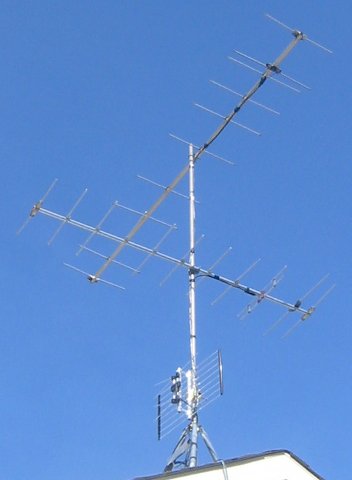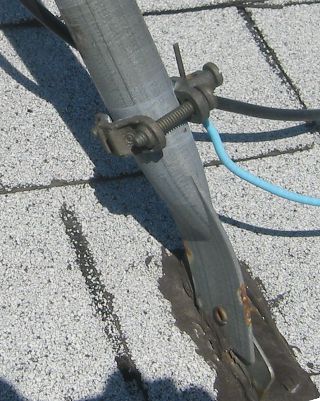Here are the other articles in this series:
Here is what the antenna looks like:

Doesn't that look great? Pure function...
The support structure is a 10 foot chain link fence top rail bought at the local home improvement store. It is attached to the roof with a tripod sold as an antenna support. The top antenna points at channel 13. The middle antenna points at channel 7. The bottom antenna (low gain UHF band) receives channels 27, 35, 40 and 51 and points between the transmitters. The cables are held to the mast with multiple wraps of black vinyl electrical tape, which seems to be the local custom.
Here is the place where the signals are combined:

Here is the place where I ground the antenna:

The requirements for grounding things like TV antennas are different from place to place. If you can't manage to ground it exactly as required, don't just give up. Ground it as best you can. You should ground the outside conductor of the cable where it comes into the building as well. You can buy a thing called a grounding block to make this convenient.
As the digital TV conversion is finally complete in my area I can provide results:
| Channel | Strength | Quality |
|---|---|---|
| 7 | 90% | 100% |
| 13 | 87% | 100% |
| 27 | 86% | 100% |
| 35 | 80% | 94% |
| 40 | 94% | 80%-100% |
| 51 | 63% | 75% |
Strength is proportional to the level of the signal. Quality is a measure of how certain the demodulator can be that a particular bit is a 0 or a 1 (higher is better). Channels 7 and 13, each with a dedicated high gain antenna, are as would be expected quite good. The rest of the channels are fairly good with the exception of channel 51. I have no real explanation for this. The transmitter is less than 3 km away. The quality of channel 40 is fluctuating. That is probably due to either noise or a reflection that is changing faster than the receiver can compensate.
posted at: 17:18 | path: /tv | permanent link to this entry